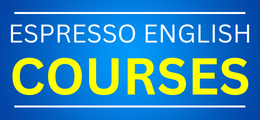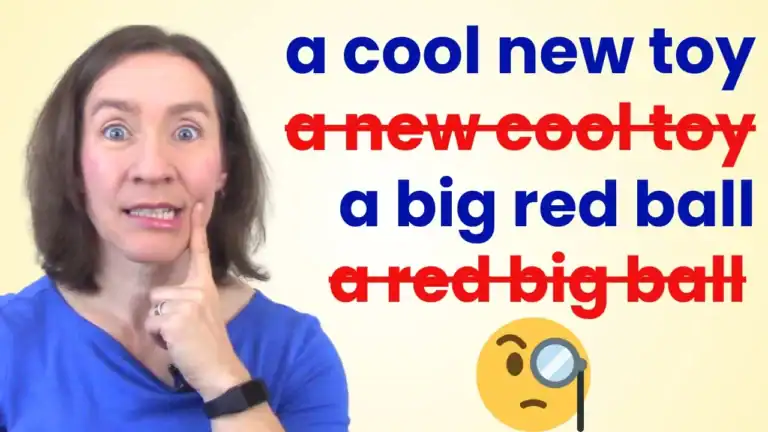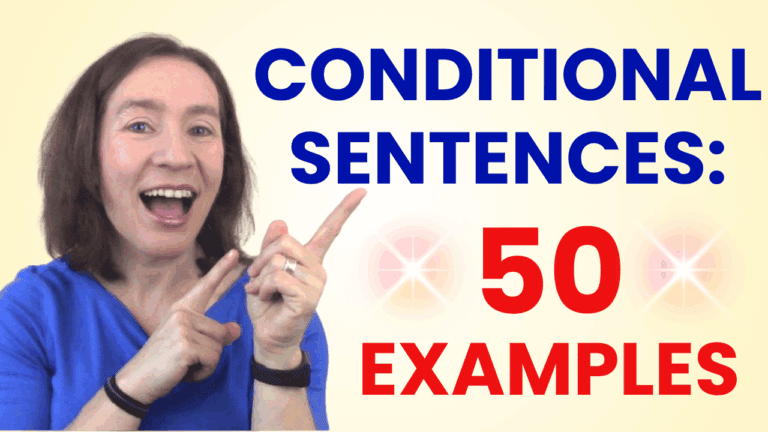Top Espresso English grammar tips:
- HAVE HAD and HAD HAD
- Difference between WORSE and WORST
- Modal verbs for deduction
- How to form questions in every verb tense!
- Should, could, and would
- Passive voice: Present and Past
- Direct and indirect questions
- Simple present or present continuous?
- Causative verbs: LET, MAKE, HAVE, GET
- Prepositional phrases
ALL Espresso English grammar tips
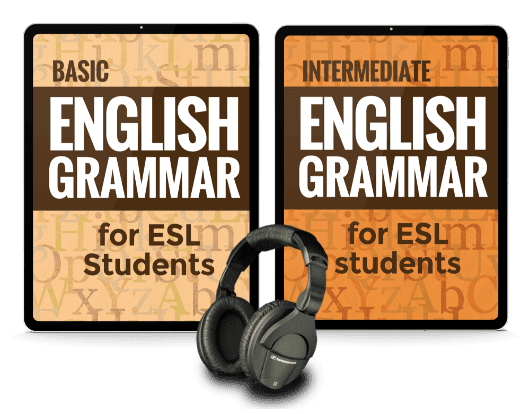
Advanced English Grammar Course
All about English Grammar
English grammar is a set of rules that tell us how to use the language properly. It’s important to learn it so we can speak and write well. If we know proper grammar, we can say what we mean correctly, and understand others better.
Today we’ll talk about basic English grammar terms and concepts, how to use English grammar, and ways you can learn more with books, courses, and websites.
Grammar topics:
- Word-level and sentence-level grammar
- Basic English grammar: Parts of speech
- Word order and sentence structure
- Independent clauses and dependent clauses
- Common grammar mistakes to avoid
- Why learn grammar & how to study it
- Recommended English grammar books
- Fun grammar quizzes and games
- Online grammar courses

Word-Level and Sentence-Level Grammar: What’s the Difference?
Understanding Word-Level Grammar
There are two main levels of English grammar: word-level grammar and sentence-level grammar. We need to know both in order to speak English and write it correctly!
Word-level grammar is the study of individual words and their forms. This includes topics such as:
- Parts of Speech: Types of words such as nouns, verbs, adjectives, adverbs, pronouns, prepositions, conjunctions, and interjections. Each part of speech plays a specific role in a sentence.
- Inflection: Inflection refers to changes made to a word to indicate tense or number. For example, adding -ed to a verb indicates past tense (e.g., walked), while adding -s indicates plural (e.g., dogs).
- Word Order: Word order is another crucial aspect of word-level grammar. In English sentences, the subject typically comes before the verb (e.g., “The dog barked”), but there are exceptions depending on the type of sentence being used.
Common errors in word-level grammar include:
- using incorrect verb tenses (ex. “I goed to the store” instead of “I went to the store”)
- confusing homophones (ex. “there,” “their,” and “they’re”)
- wrong prepositions (ex. saying “I’m bored from my job” instead of “I’m bored with my job”).
Understanding Sentence-Level Grammar
Sentence-level grammar focuses on the structure and meaning of sentences. This includes topics such as:
- Syntax: The rules about how words are arranged in a sentence. For example, English sentences typically follow a subject-verb-object structure (e.g., “She ate the apple”), but other languages may use different structures.
- Semantics: the meaning of words and sentences. This includes understanding word definitions, connotations, and figurative language such as metaphors and similes.
- Discourse: Discourse refers to how language is used in context. This includes understanding things like tone, register (formal or informal language), and pragmatics (how language is used to achieve specific goals).
Common errors in sentence-level grammar include:
- run-on sentences (ex. “I went to the store it was far away I bought some milk”)
- wrong word order (ex. “I like very much this movie.”)
- using language that is too formal or too informal for the context. (LINK formal, semi-formal etc.)
Basic English Grammar: Parts of Speech
Parts of speech are the different types of words we have in the English language – like nouns, verbs, adjectives, adverbs, pronouns, prepositions, and conjunctions. These are the building blocks of sentences.
Nouns are words that refer to people, places or things. They can be proper nouns such as names or common nouns like objects.
Verbs are action words that express what someone is doing or what is happening. We also have modal verbs that express necessity or possibility (ex. can, could, should, might) and state verbs that describe a quality or status,
Adjectives describe a noun by providing more information about its characteristics, while adverbs provide more information about verbs by describing how something is done.
Pronouns replace nouns to avoid repetition in a sentence.
Prepositions are small words that link nouns and pronouns with other parts of the sentence, while conjunctions connect two ideas together.
Using these parts of speech correctly helps ensure that a sentence makes sense and conveys its intended meaning. Let’s learn more about each part of speech.
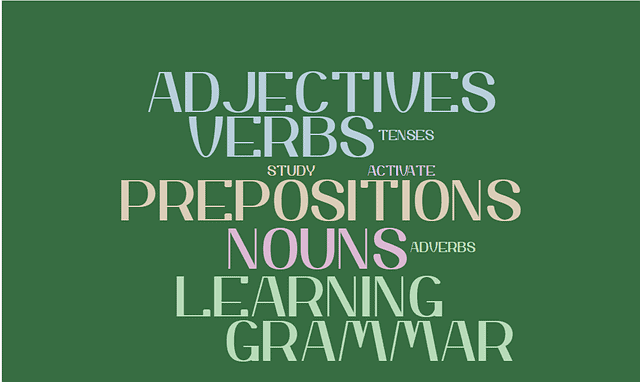
Nouns: Words for People, Places, Things, or Ideas
Nouns are words that represent people, places, things, or ideas. Nouns can be further classified into different types such as common nouns and proper nouns. Common nouns refer to general things, while proper nouns are names of specific individuals, places, or things.
For example:
- Common noun: man
- Proper noun: John
There are also concrete and abstract nouns. Concrete nouns refer to physical objects, and abstract nouns refer to concepts or ideas.
For example:
- Concrete noun: table
- Abstract noun: love
Countable and uncountable nouns are also important to understand. Countable nouns can be counted using numbers, while uncountable ones cannot be counted in the same way.
For example:
- Countable noun: book
- Uncountable noun: water
Pronouns: Replacing Nouns or Noun Phrases
Pronouns are words that replace nouns or noun phrases to avoid repetition in a sentence. For example:
- Repetitive sentences: Mary is my friend. Mary studies English at the university. I went to Mary’s house for dinner last week.
- Sentences using pronouns: Mary is my friend. She studies English at the university. I went to her house for dinner last week.
There are different types of pronouns such as personal pronouns (I, you, he, she, it, we, they), possessive pronouns (mine, yours, his, hers, ours, theirs), demonstrative pronouns (this, that, these, those), and more.
For example:
- Personal pronoun: She is going to the store.
- Possessive pronoun: This is my grammar book.
- Demonstrative pronoun: These are the shoes I want to buy.
Adjectives: Describing Nouns and Pronouns
Adjectives describe nouns and pronouns by providing more details about them. They can describe the size, shape, color, age, etc.
For example:
- She bought a blue
- I’ll have a large
- We live in an old
Check out this list of 100 common adjectives in English!
It’s also important to learn the proper order of adjectives in English – for example, we say “the big red ball” and not “the red big ball” – that doesn’t sound natural.
Adjectives also have comparative and superlative forms. Comparative adjectives compare two items while superlative adjectives compare three or more items.
For example:
- Comparative adjective: The red car is faster than the blue car.
- Superlative adjective: The red car is the fastest among all cars.
Adverbs: Modifying Verbs, Adjectives, or Other Adverbs
Adverbs modify verbs by telling us how an action was performed. They can also modify adjectives and other adverbs by adding more detail about them.
Adverbs can be categorized into different types based on the topics they modify such as time (when), place (where), manner (how), degree (to what extent), and more.
For example:
- Time adverb: She arrived early for the meeting.
- Place adverb: He looked everywhere for his keys.
- Manner adverb: She danced gracefully on stage.
- Degree adverb: He worked extremely hard to finish the project on time.
Verbs: Words for Action and State
Verbs can be action words like run, jump, make, think, say, and get.
Verbs can also tell us the state of something – state verbs include be, appear, and seem.
We use them in different verb tenses, which tell us about the time when the action happened:
- Present simple: I work every day.
- Past simple: I worked late yesterday.
- Future simple: I will work / I am going to work tomorrow.
- Present continuous: I am working right now.
- Past continuous: I was working last night.
- Future continuous: I will be working next Saturday.
- Present perfect: I have worked here for 5 years.
- Past perfect: I had worked at my last company for 1 year before I left.
- Future perfect: In January, I will have worked here for 10 years.
- Present perfect continuous: I have been working on this project since September.
- Past perfect continuous: I had been working hard when I was interrupted.
- Future perfect continuous: By tomorrow morning, I will have been working for 12 hours straight.
Word order and sentence structure
The most common word order in English phrases is subject-verb-object:
- I painted the house.
I = subject
painted = verb
the house = object - She loves dogs.
She = subject
loves = verb
dogs = object - We’re buying a car.
We = subject
‘re buying = verb
a car = object - They gave me a gift.
They = subject
gave = verb
me = indirect object
a gift = direct object
We can then add more detail with prepositional phrases:
- We’re buying a car from a local dealership.
- She loves dogs that are very fluffy.
- Before leaving for vacation, I painted the house.
- They gave me a gift for my birthday.
For more detail and examples of how to build sentences, take this lesson on 4 types of sentence structure:
- simple sentences
- compound sentences
- complex sentences
- compound-complex sentences.

Independent Clauses and Dependent Clauses
An independent clause is a phrase that has a subject and verb, so it can stand alone as a sentence. For example:
- We went for a walk.
- My mother lives in New York.
- I like learning English.
A dependent clause is a phrase that cannot stand alone as a sentence – it must be connected to an independent clause to form a complete sentence.
For example:
- After the rain stopped, we went for a walk.
- My mother, who is retired, lives in Florida.
- I like learning English, although I find it difficult.
Relative Pronouns Introducing Dependent Clauses
Many dependent clauses start with relative pronouns such as who, when, where, whose, which, and that. For example:
- I spoke to the woman who lives next door.
- Do you remember the time when we got lost in the city?
- That’s the house where I grew up.
- I have a cousin whose kids are very talented.
- Is this the software that you need?
- Our house, which we bought last year, already needs some repairs.
Click here for more information on relative clauses, with examples and a quiz!
Prepositional Phrases
A prepositional phrase includes a preposition (in, on, at, by, with, to, for, etc.) followed by its object (a noun or pronoun). The entire phrase functions as either an adjective modifying a noun or pronoun, or as an adverb modifying a verb, adjective, or another adverb.
For example:
- The books on the top shelf are new.
“On the top shelf” acts as an adjective describing the noun “books” - She sang with passion.
“With passion” acts as an adverb describing the verb “sang.”
Click here for more information about prepositional phrases and examples!

Common Grammar Mistakes to Avoid
Irregular Verbs in English
Many common English verbs are irregular – they don’t follow the typical pattern of adding -ed to form the past tense. Instead, they have their unique forms that must be memorized.
For example:
- Present: I sing
- Past: I sang (not “I singed”)
- Present perfect: I have sung
Here’s an irregular verb that’s the same in all three forms:
- Present: I always put my coat in the closet.
- Past: I put the milk in the fridge yesterday. (not “I putted”)
- Present perfect: I’ve never put on high heels.
It’s essential to know these irregular verb forms since using them incorrectly can lead to confusion and affect a sentence’s meaning. Practice and repetition are the best ways to learn and remember irregular verb forms. Here’s a huge irregular verbs list to help you!
Avoid double negatives
A double negative is when two negative words are used in a phrase, canceling each other out. This is incorrect in English. For example:
- Incorrect: “I don’t have no money”
- Correct: “I don’t have any money.”
- Correct: “I have no”
In some languages, it is possible to have double negatives, but we cannot do this in English.
Mistakes with A, AN, THE
We use A and AN before singular countable nouns that are not specific, and THE before nouns when we are referring to something specific. Some common errors made by English learners include:
- Using a/an before uncountable nouns: “an information”
Instead, say “some information” or “a piece of information” - Using “the” before general nouns: “I like the pizza.”
Instead, say “I like pizza” (in general) or “I like the pizza at this restaurant” (specific) - Using “the” before country names: “I’m going to the Brazil.”
Most countries do not use “the”: “I’m going to Brazil.” (Exceptions include the U.S., the U.K., the Philippines, and a few others)
Learn more about common errors with a, an, the
Auxiliary Verbs or Helping Verbs
It’s important to use the correct auxiliary verb (also called a “helping verb”). Auxiliary verbs include be, do, have, will, would, should, could, can, may, might, and must.
Many English learners make mistakes with these by forgetting to use an auxiliary verb, or using the wrong one.
Here are some correct sentences using auxiliary verbs:
- I am going to school. (Not “I going”)
- He doesn’t like ice cream. (Not “He not like / He no like”)
- Did you go to the party last night?
- She has finished her homework.
- They will play soccer tomorrow.
- You should take your medicine on time.
- He could have done better if he had studied harder.

When considering grammar errors, keep in mind that there are some grammar differences between American English and British English – for example:
- In American English, “family” takes a singular verb: “My family is visiting me next week.”
- In British English, “family” can take a singular verb or a plural verb: “My family is visiting me next week” or “My family are visiting me next week.”
Why Learn English Grammar?
There are so many grammar rules (and exceptions to the rules) in the English language… why should you study them?
Grammar helps you use English properly. It gives you guidelines for how to put together correct phrases sentences, so that you can avoid mistakes and miscommunication. It’s not so important to know all the technical grammar terms… but you DO need to know how to use grammar correctly.
Proper grammar makes you a more effective speaker and writer of English – you will be able to express your ideas more clearly, so that people can understand exactly what you want to communicate.
Also, good grammar skills make a good impression! The way we speak or write reflects our level of education and intelligence. When we use proper grammar, other people tend to respect us more because we appear more knowledgeable.
How To Study Grammar
You can learn English grammar through ESL classes or private lessons with an English teacher. Another way to learn is by self-study, and there are many books, courses, and websites that can help – you can read more about them in the next section!
One important tip for learning grammar is always to put it into practice. Don’t just read about grammar rules and topics – you need to use them actively if you want to remember them and make them part of your own English.
Many grammar books and grammar courses come with quizzes to practice and review – always do these and check your answers! Also, every time you study a grammar topic, try to create your own example sentences using that aspect of English grammar.
You can check your writing using online grammar correction like Grammarly, which checks for spelling mistakes, grammar errors and suggests corrections.
Like any skill, mastering grammar requires consistent practice over time. If you focus on learning grammar, practicing grammar, and getting corrections on your grammar, then you will begin to use it naturally when speaking and writing in English. Eventually you will “internalize” the grammar rules, so that you can use proper grammar without thinking too much about it!

Learning English Grammar: Recommended Books
If you are looking for a classic grammar book that covers the basics, “The Elements of Style” by William Strunk Jr. and E.B. White is an excellent choice. This book has been around for over 100 years and is still widely used today – including by native speakers – because it provides clear and concise explanations of grammar terms, rules, punctuation, and writing style.
This book doesn’t waste time with lengthy explanations or examples; instead, it gets straight to the point. The authors provide practical advice on how to write clearly and effectively, from choosing strong verbs to avoiding unnecessary adjectives. “The Elements of Style” is a great reference for both English language learners and native English speakers looking to improve their writing.
Another popular option for those looking to improve their grammar skills is “English Grammar in Use” by Raymond Murphy. This self-study book is designed for learners at different levels, from beginner to advanced.
“English grammar in use” focuses on practical exercises that help learners apply what they’ve learned in real-world situations. Each unit includes clear explanations followed by plenty of exercises to practice and review. It comes with an answer key so learners can check their work as they go along. This makes it a great choice for those who prefer self-directed learning or don’t have access to formal language classes.
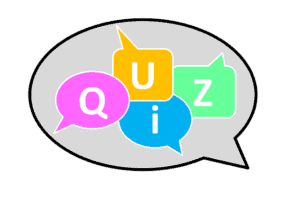
Fun Grammar Games and Quizzes Online
Ready to put your grammar skills to the test? Here are some fun online games and quizzes that will test your understanding of everything from basic sentence structure to complex dependent clauses.
One popular option is Perfect English Grammar’s online quizzes, which cover a wide range of topics including English verb tenses, subject-verb agreement, and pronoun usage. With multiple-choice questions and immediate feedback on each answer, this quiz is a great way to identify areas where you may need some extra practice.
If you’re looking for a more interactive experience, try out the grammar games on Funbrain. From “Grammar Gorillas” (a game where you help gorillas identify parts of speech) to “Mad Libs Junior” (a fill-in-the-blank story game that reinforces knowledge of nouns, adjectives, and verbs), these games are both educational and entertaining.
Another option is the website English Central, which offers a variety of grammar exercises that use real-life videos as context. For example, you might watch a short clip about cooking or travel and then complete exercises related to verb tense or prepositions based on what you’ve just seen. This approach can be especially helpful for visual learners who prefer hands-on activities over traditional textbook-style learning.
EnglishClub also has a lot of mobile-friendly grammar games focusing on parts of speech – nouns, verbs, adjectives, and adverbs.
No matter what type of learner you are or how much experience you have with English grammar rules, there’s an online game or quiz out there that can help take your grammar skills to the next level. So why not make learning fun by incorporating some of these options into your study routine today?

Online Courses on English grammar
An online course can be a great way to improve your English grammar, especially if it has interactive elements. Courses help you learn quickly and effectively because they take you through an organized sequence of lessons, so you can improve your grammar skills step by step.
“Grammarly Handbook” offers interactive lessons, quizzes, and personalized feedback to help users improve their grammar skills. It covers everything from basic grammar rules to more advanced topics like tone and style.
Similarly, “edX English Grammar and Style” is a free online course that includes video lectures, quizzes, and assignments designed to help learners improve their writing skills. This course is self-paced and requires significant time commitment (around 10 hours per week).
We also have two great options here at Espresso English: our Basic & Intermediate English Grammar E-Books + Audio, and our Advanced English Grammar Course.
The Basic and Intermediate English Grammar E-Books teach you essential English grammar – the most important verb tenses and rules around nouns, prepositions, sentence structure, and more. The e-books include grammar quizzes to help you practice, and audio so that you can listen to the lessons.
The Advanced English Grammar Course goes into lots of detail and covers more advanced topics so that you can write more complex sentences and master English grammar. This online course includes not only grammar quizzes, but also writing tasks so that you can easily practice using the grammar yourself. There’s even the option to send us your writing and get grammar correction from an Espresso English teacher.
Both the Basic and Intermediate English Grammar E-Books and the Advanced English Grammar Course have “short and sweet” lessons, so you can improve your English grammar skills in only a few minutes a day! They are perfect for English language learners who are busy and don’t have much time to study.





